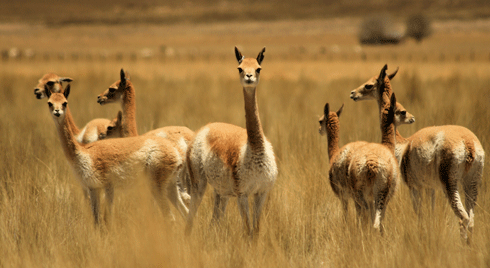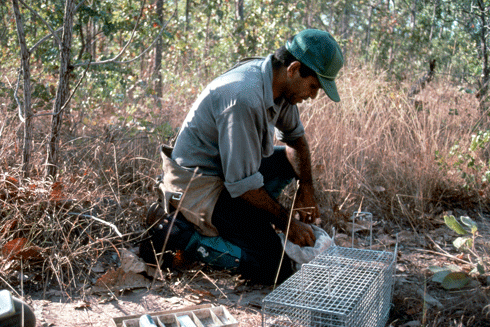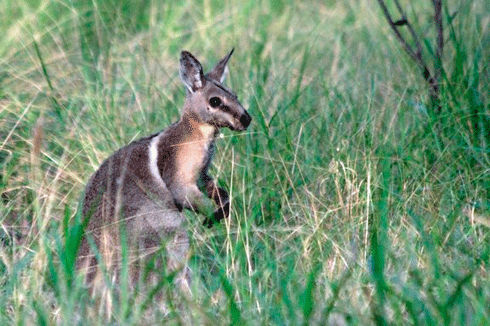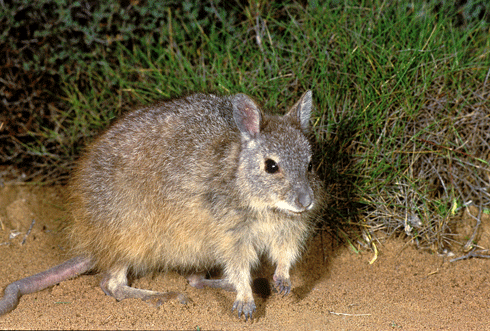
|
Published:
Mammal extinctions – new thinking
With an increasing list of endangered mammals slipping towards extinction in Australia, leading ecologists are aiming for solutions with more effort on science-based changes in management practices on the ground.
At August’s INTECOL conference1 in Brisbane, the largest gathering of ecologists ever to be held in the southern hemisphere, Professor Iain Gordon with CSIRO Sustainable Ecosystems and Professor Chris Johnson from James Cook University will be chairing a panel of experts for a symposium session on Australian mammal extinctions, and their patterns, process and prevention.
‘The scientific community has found itself in a position where we have identified the threats to Australian mammal species and documented the loss,’ Professor Gordon says. ‘The role of science now must turn more directly to identifying the opportunities for assisting the survival of these mammals.’
Professor Gordon should know about how to execute such opportunities; he was co-author and editor of a recently published book2 on the South American Vicuña’s comeback from the brink of extinction. Once abundant in the Andes, this wild relative of the Llama suffered a sharp population drop in the 1960s due to international demand for its fleece, which is finer than that of the merino sheep. An international moratorium on the sale of Vicuña fleece in 1969 saw populations recover enough for a community-based conservation policy to be enacted in 1987. Population numbers of Vicuña have remained healthy ever since, making it one of the few success stories of wildlife conservation worldwide.
‘This case has linked economic, social and conservation research to provide a unique insight into the viability of community-based wildlife management of a species,’ Professor Gordon says, highlighting the relevance of the scenario for Australia’s endangered mammals.
Australia leads the world in mammal extinctions over the last 200 years with 27 extinct mammals and another four currently critically endangered.3 However, the causes of this dramatic decline are not related to international exploitation as in the Vicuña’s predicament. The medium-sized mammal species of Australia have been dealt a different suite of issues. The introduction of feral animals – particularly cats and foxes – increased grazing pressure, altered fire regimes, the clearing of habitat for development and production, and now climate change, have all had significant impact. With this onslaught of pressures, what options exist to ensure the survival
of mammal species facing extinction?
Professor Gordon believes there are two immediate ones: strengthening the national reserve system and effecting better land management outside the national park network to ensure species are maintained in the broader landscape.
Predation by feral cats and foxes is seen as the highest risk to medium-sized mammals in Australia, so management directed at keeping threatened mammals off the extinction list is currently focused on protecting vulnerable species on islands or in intensively managed mainland sanctuaries, inside predator proof fences. This has been successful in recent years, saving species such as the rufous hare wallaby, also known as the mala, from extinction.
But can on-ground management be delivered that would allow medium-sized mammals to exist outside a small number of intensively managed sanctuaries? Dr Barry Traill from Pew Australia is one of the experts discussing this issue at the INTECOL conference.
‘Unfortunately many proven management approaches, such as fenced sanctuaries, are prohibitively expensive over large areas. What’s needed is an increased focus on cheaper landscape-scale solutions that may work to maintain and re-establish many at-risk mammals, in many habitats,’ Dr Traill says.
‘For this we must develop broad-scale management interventions that not only reduce the risk of predators, but also address the issues of overgrazing by domestic and feral livestock on privately owned land. This will have to include public payments for land managers to reduce grazing pressure and control feral animals, particularly in hotspots in the landscape that offer critical habitat for native mammals.’

|
|
Community-based conservation was an outstanding success for the Vicuña. Credit: Jerry Laker
|
Some of the preferred approaches being put forward by scientists are already controversial. One, translocations or ‘assisted colonisation’, involves a triage process for moving species to alternative habitat when their native habitat can no longer support a viable population. Their new location has food sources and shelter matched to their original habitat and extinction pressures removed. But lessons from previous failed species introductions makes this a contentious option, although if the aim is ultimately to maintain a species’ crucial genetic diversity against environmental pressures, and particularly these days, climate change, it could remain part of the package of solutions.
Tara Martin of CSIRO Sustainable Ecosystems has spent 10 years helping to identify the priority conservation areas that can maintain or help recover native plant and animal populations. ‘Assisted colonisation flies in the face of traditional conservation strategies,’ she points out. ‘In fact there are entire disciplines devoted to managing the negative consequences of moving species into new regions and systems around the globe. The question we are tackling is when do the benefits of translocating a species or ecosystem outweigh the risks of not doing so?’

|
|
A CSIRO researcher collects a trapped bandicoot during research on small mammal populations in Kakadu National Park. Credit: CSIRO Sustainable Ecosystems
|
But ‘unassisted translocations’ seem to be taking place already, affecting species interactions. Migratory bird flights, for example, have recorded shifting path and departure time as birds adapt to the changing temperatures that trigger their movement. A study conducted by Macquarie University in 2006 found that southern hemisphere migratory birds including sandpipers, kingfishers, bee eaters and plovers were arriving on average 3.5 days earlier to their breeding grounds.4
The re-introduction of dingoes is another controversial approach to supporting Australian mammal populations (see Ecos 147). Dr Chris Johnson from James Cook University is the author of Australia’s Mammal Extinctions: A 50 000 Year History, which discusses the role of dingoes in the Australian landscape. ‘There is now good evidence that a stable population of dingoes suppresses the numbers and activity of foxes and cats, and some other feral animal species as well,’ he highlights. ‘The effect of using an extra predator like the dingo to hold down populations of foxes and cats is that the total intensity of predation on smaller native mammals can be reduced.’
Bringing back the dingo has many sheep and cattle farmers raising their eyebrows because the wild dogs are known to kill stock. But Dr Johnson says guardian dogs can protect stock herds by keeping dingoes out of range. This still allows the dingoes to have a beneficial effect in the ecosystem. ‘Current trials of Maremma dogs at Dunluce sheep station in north-west Queensland demonstrate that they can be effective dingo deterrents in a pastoral zone.’
Further research on the impacts of fire, grazing, invasive species and climate change on Australian mammals would be extremely valuable, but ecologists recognise that crucial management decisions need to be made now.
With limited information available on the response of endangered mammals to management intervention, Professor Gordon believes managers and scientists need to work together in an adaptive management framework with research focused on overall systems. This would provide ‘best of knowledge’ guidelines with monitoring and evaluation to assess the consequences of on-ground action, inform the adaptive management framework, and provide guidance not only for future research work, but also for ongoing management needs.

|
|
The endangered bridled nailtail wallaby (Onychogalea fraenata) is hanging on with concerted conservation efforts in Australia. Credit: Liana Joseph
|
‘The eyes of the world are on Australia at the moment,’ Professor Gordon says. ‘We have an opportunity to show how we can apply science through collaborative agreements with land managers to reduce the threats and protect endangered species.’
‘If we allow these species to become extinct, where will we stand on the global league table of environmentally engaged societies?’
1 INTECOL: The Tenth International Congress on Ecology, http://www.intecol10.org
2 Gordon IA (Ed.) (2008) The Vicuña: The Theory and Practice of Community Based Wildlife Management. Springer Verlag.
3 Australian Government Department of Environment and Heritage, EPBC: http://www.environment.gov.au/cgi-bin/sprat/public/publicthreatenedlist.pl?wanted=fauna
4 Beaumont J, McAllan IAW and Hughes L (2006) A matter of timing: changes in the first date of arrival and last date of departure of Australian migratory birds. Global Change Biology 12, 1339–1354.




